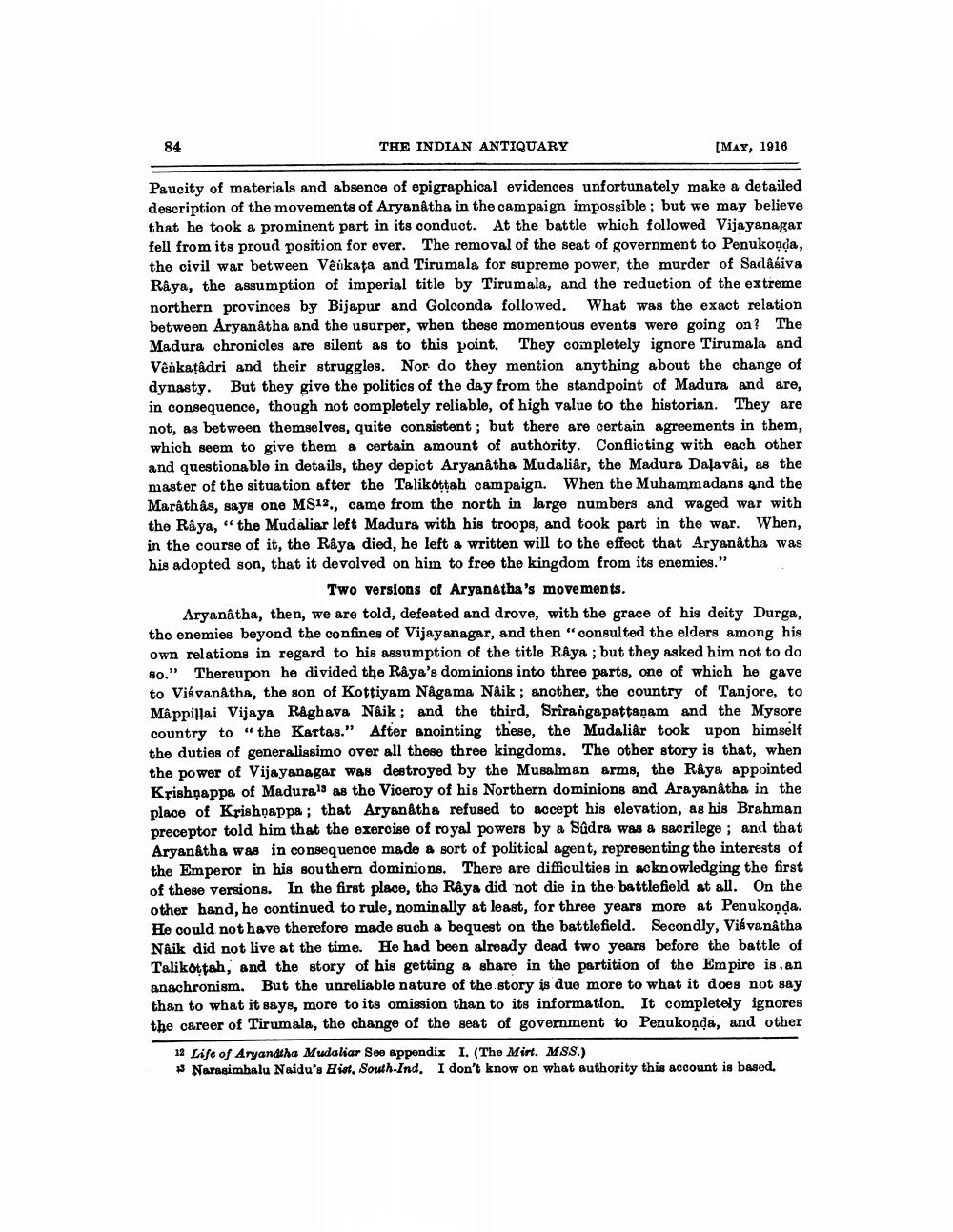________________
84
THE INDIAN ANTIQUARY
[May, 1916
Paucity of materials and absence of epigraphical evidences unfortunately make a detailed description of the movements of Aryanatha in the campaign impossible ; but we may believe that he took a prominent part in its conduct. At the battle which followed Vijayanagar fell from its proud position for ever. The removal of the seat of government to Penukonda, the civil war between Veikata and Tirumala for supreme power, the murder of Sadasiva Raya, the assumption of imperial title by Tirumala, and the reduction of the extreme northern provinces by Bijapur and Golconda followed. What was the exact relation between Aryanatha and the usurper, when these momentous events were going on? The Madura chronicles are silent as to this point. They completely ignore Tirumala and Venkatâdri and their struggles. Nor do they mention anything about the change of dynasty. But they give the politics of the day from the standpoint of Madura and are, in consequence, though not completely reliable, of high value to the historian. They are not, as between themselves, quite consistent; but there are certain agreements in them, which seem to give them a certain amount of authority. Conflicting with each other and questionable in details, they depict Aryanatha Mudaliar, the Madura Dalavâi, as the master of the situation after the Talikottah campaign. When the Muhammadans and the Marâthâs, says one M$12., came from the north in large numbers and waged war with the Raya, "the Mudaliar loft Madura with his troops, and took part in the war. When, in the course of it, the Rêya died, he left a written will to the effect that Aryanatha was his adopted son, that it devolved on him to free the kingdom from its enemies."
Two versions of Aryanatha's movements. Aryanatha, then, we are told, defeated and drove, with the grace of his deity Durga, the enemies beyond the confines of Vijayanagar, and then "consulted the elders among his own relations in regard to his assumption of the title Raya; but they asked him not to do 80." Thereupon he divided the Râya's dominions into three parts, one of which he gave to Visvanátha, the son of Kottiyam Nagama Naik, another, the country of Tanjore, to Mappillai Vijaya Raghava Naik; and the third, Srirangapattanam and the Mysore country to "the Kartas." After anointing these, the Mudaliar took upon himself the duties of generalissimo over all these three kingdoms. The other story is that, when the power of Vijayanagar was destroyed by the Musalman arms, the R&ya appointed Kfishộappa of Madura' as the Viceroy of his Northern dominions and Arayanatha in the place of Krishnappa; that Aryanatha refused to accept his elevation, as his Brahman preceptor told him that the exercise of royal powers by a Sadra was a sacrilege ; and that Aryanatha was in consequence made a sort of political agent, representing the interests of the Emperor in his southern dominions. There are difficulties in acknowledging the first of these versions. In the first place, tha Raya did not die in the battlefield at all. On the other hand, he continued to rule, nominally at least, for three years more at Penukonda. He could not have therefore made such a bequest on the battlefield. Secondly, Visvanatha Naik did not live at the time. He had been already dead two years before the battle of Talikottah, and the story of his getting a share in the partition of the Empire is an anachronism. But the unreliable nature of the story is due more to what it does not say than to what it says, more to its omission than to its information. It completely ignores the career of Tirumala, the change of the seat of government to Penukonda, and other
12 Life of Aryandtha Mudaliar See appendix I. (The Mirt. MSS.)
Narasimhalu Naidu's Hist, South Ind. I don't know on what authority this account is based.




